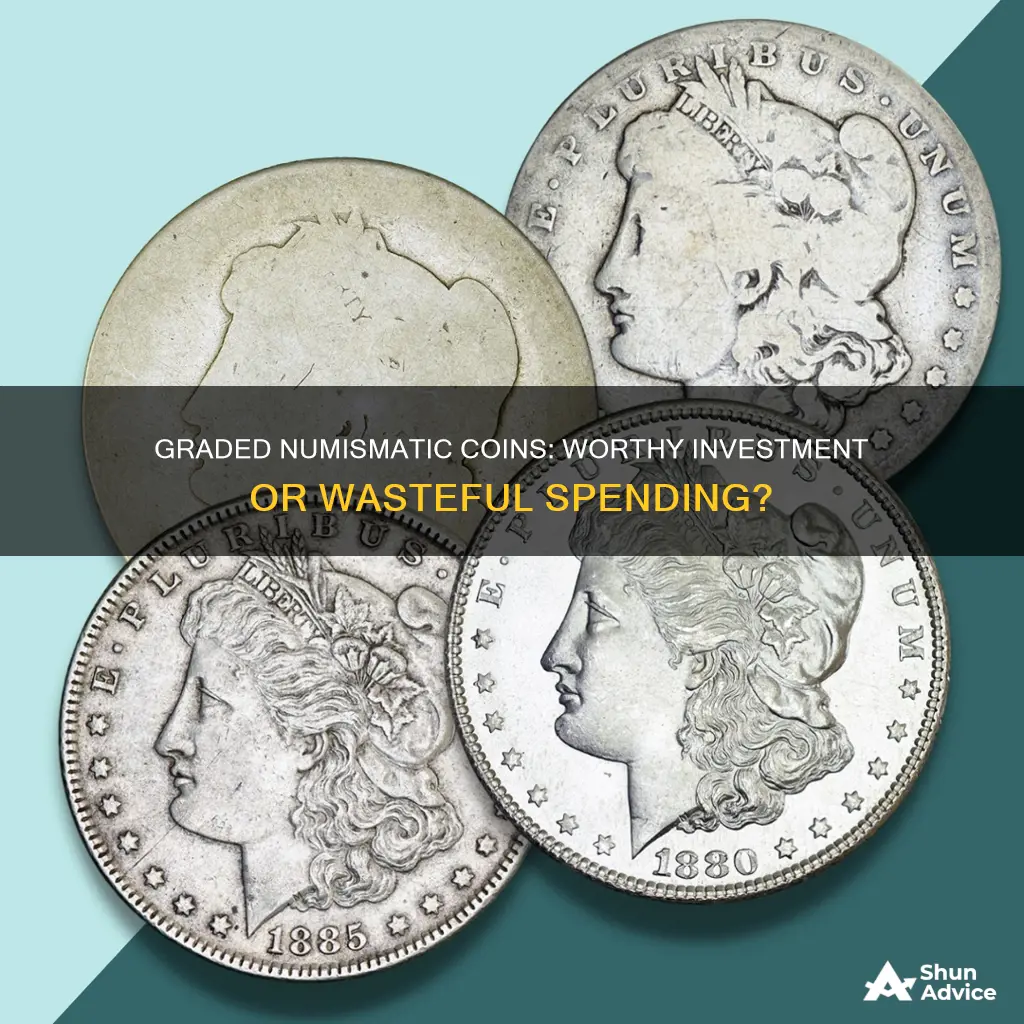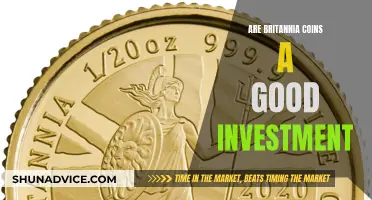
Investing in graded coins is a complex and nuanced topic that requires careful consideration. The value of graded coins is influenced by various factors, and it's important to understand the dynamics of the numismatic market before making any investment decisions.
Numismatic coins, or collectible coins, derive their value from intangible factors such as age, rarity, year of issue, design, and the mint at which they were struck. This market is complex, illiquid, and challenging to navigate, especially for new investors. The value of numismatic coins is highly subjective and influenced by numerous variables, making it difficult to predict their resale value.
On the other hand, bullion coins offer a more straightforward investment proposition, with their value primarily driven by the underlying precious metal content. Bullion is widely recognized, liquid, and has a transparent valuation process based on the type and weight of the metal.
When considering investing in graded coins, it's essential to weigh the potential benefits against the risks. Graded coins can provide a standardized indication of a coin's condition, enhancing its appeal and value. They also instill confidence in buyers by assuring authenticity and accuracy in grading. Additionally, the encapsulation of graded coins protects them from environmental factors and mishandling, preserving their condition over time.
However, it's crucial to factor in the costs associated with grading, as these expenses can impact the overall return on investment. Collector preferences and broader numismatic trends can also influence the value of graded coins. It's recommended to seek guidance from mentors or experts and thoroughly research the value and potential future value of coins before investing.
What You'll Learn

The pros and cons of investing in graded coins
Graded coins are an attractive prospect for collectors and investors alike. However, there are several factors to consider when deciding whether to invest in graded coins. Here are some pros and cons to help you make an informed decision.
Pros:
- Standardized grading: Grading systems such as the Sheldon Coin Grading Scale provide a universal language for assessing coin quality. This makes it easier for collectors and investors to evaluate and compare coins.
- Authenticity and protection: Graded coins are typically certified by reputable services, assuring buyers of their authenticity and reducing the risk of buying counterfeit coins. The encapsulation of graded coins also protects them from environmental damage and tampering, preserving their condition over time.
- Enhanced marketability: Graded coins often instill confidence in buyers, as the certification provides a clear indication of their condition and value. This can make graded coins more marketable and potentially increase their appeal to collectors.
- Diversification: Rare coins can add diversity to an investment portfolio focused on stocks and bonds. They are also a good way to convert paper assets into tangible assets, especially during times of economic uncertainty.
- Potential for profit: Historically, rare coins have offered significant profit potential above the underlying metal value. Prices of select coins appreciated by over 1000% between 1976 and 1980, and by 600% from 1982 to 1989.
Cons:
- Costs: Grading fees can be significant and may outweigh the potential increase in a coin's value. It is important to consider these costs when deciding whether to grade a coin or purchase a graded one.
- Subjectivity: The value of graded coins is still subject to individual preferences, collector trends, and market dynamics. Just because a coin has a high grade does not mean it will be rare or valuable.
- Limited investment potential: While graded coins may be suitable for collectors or buyers seeking reassurance about a coin's condition, they are generally not recommended as a serious investment. The high premiums charged by dealers for graded coins can negate any potential profit.
- Liquidity: The market for graded coins is smaller and less liquid than the bullion market. It may be challenging to find willing buyers or sellers at desired prices, especially for coins with subjective attributes like rarity and collectability.
- Learning curve: The numismatics market is complex and involves a steep learning curve. Investors need to conduct extensive research to understand the various grading systems, coin characteristics, and market dynamics before making informed investment decisions.
Bitcoin Profit Margins: How to Find Success
You may want to see also

How to determine the value of a graded coin
Coin grading is a systematic process used to evaluate and assign a standardized grade to a coin based on its condition, wear, and overall state of preservation. The primary purpose of coin grading is to provide a universally accepted and consistent way to communicate a coin’s quality and rarity. This grading system helps collectors, investors, and enthusiasts assess the value and authenticity of a coin accurately.
Examine the Coin's Wear:
Start by inspecting the high points of the coin where wear is most likely to occur. Look for smoothness or dulling of the metal, indicating varying degrees of wear.
Assess Lustre and Toning:
Hold the coin at different angles under a light source to observe its lustre. Note any toning or discoloration, which can impact both the visual appeal and the overall grade.
Inspect for Surface Marks and Scratches:
Carefully examine the entire surface for any marks, scratches, or blemishes. These imperfections can significantly affect a coin’s grade, especially if they are prominent or numerous.
Evaluate Striking Details:
Focus on the coin’s design elements. Check how well-defined and sharp the details are, paying attention to the central and peripheral features. Well-preserved striking details contribute to a higher grade.
Examine the Rim for Dents or Damage:
Inspect the rim of the coin for any dents or damage. A smooth, undisturbed rim is generally preferable, as dents can affect both aesthetics and structural integrity.
Use a Magnifying Glass:
Employ a magnifying glass to get a closer look at the coin’s details. This tool can reveal subtle imperfections that might not be apparent to the naked eye.
Reference Grading Guides:
Utilize reputable coin grading guides or online resources to cross-reference your observations. This step can provide additional insights and ensure a more accurate assessment.
Practice Consistency:
Strive for consistency in your grading approach. Over time, developing a consistent methodology will enhance your ability to accurately evaluate different coins.
Use Professional Grading Services:
Opting for professional grading services like PCGS, NGC, or ANACS offers numerous advantages, including authentication, preservation, and increased marketability. The graded coin is returned in an appealing plastic container, including certification of the grade, authenticity, and condition.
Consider the Costs:
While grading can potentially increase a coin’s value, it’s essential to factor in the costs associated with the grading process. Grading fees can vary, and these costs may impact the overall return on investment.
The Bitcoin Investors: Who's Taking the Plunge?
You may want to see also

The cost of grading a coin
For NGC, coin grading is only available to members, with an Associate account being required for $25 per year. The standard grading cost for U.S. or world coins up to $3,000 in value is $40 per coin with a 16-day turnaround, while express grading for the same coin is $80 with a 5-day turnaround. NGC also offers an Economy tier for coins valued at $300 or less, with a turnaround of 35 days.
PCGS offers regular grading for coins worth $2,500 and less at $38, with a turnaround of about 50 business days. They also offer express grading for coins worth less than $10,000 at $65, with a turnaround of 15 business days. PCGS's economy tier for coin grading is $22 for coins valued at $300 or less, with an estimated turnaround time of 70 business days.
It's important to note that these costs do not include return shipping, which can range from $22 to $150 depending on the value of the coin(s) and the shipping service used. Additionally, there may be extra costs for faster turnaround times, ancillary services, or additional guarantees.
The total cost for grading a coin can range from around $120 to over $200, depending on the service, the coin's value, and the desired turnaround time. It's important to consider these costs when deciding whether to grade a coin, especially if you are a collector or investor looking to increase the value of your coins.
Strategizing for Bitcoin's Crash: A Guide to Investing
You may want to see also

The process of grading a coin
Coin grading is a systematic process used to evaluate and assign a standardised grade to a coin based on its condition, wear, and overall state of preservation. The primary purpose of coin grading is to provide a universally accepted and consistent way to communicate a coin's quality and rarity. This grading system helps collectors, investors, and enthusiasts assess the value and authenticity of a coin accurately.
- Examination of the Coin's Surface and Details: The grader will carefully examine the coin's surface, looking for any wear, tear, scratches, or other imperfections. They will also assess the coin's lustre and toning, as well as the sharpness and clarity of its design elements.
- Determining the Coin's Grade: Based on the predetermined scale, the grader will assign a grade to the coin, indicating its relative state of preservation. The assigned grade provides crucial information to potential buyers or sellers.
- Authentication and Verification: Before assigning a final grade, the grader will authenticate the coin to ensure it has not been cleaned, altered, or tampered with. They will also verify the coin's label, description, and characteristics, including the strength of the strike, quality of the strike, lustre, marks, toning, and visual appeal.
- Encapsulation and Protection: Once graded, the coin is typically encapsulated in a protective holder or slab to preserve its condition and ensure its authenticity. This also helps prevent tampering and protect the coin from environmental factors that could damage it.
- Final Inspection and Shipment: After encapsulation, the coin undergoes a final inspection to verify its grade, description, and authenticity. Once inspected, the coin is then packaged and shipped to the customer.
It is important to note that coin grading is both an art and a science, and it requires a keen eye and a good understanding of the key factors that influence a coin's grade. While anyone can learn to grade coins with practice, becoming a professional grader requires a high level of expertise and precision.
Calculating Bitcoin ROI: A Step-by-Step Guide
You may want to see also

The risks of investing in graded coins
Graded coins are not always worth more than their ungraded counterparts. In fact, there are several risks associated with investing in graded coins that potential buyers should be aware of. Here are some key considerations:
- Costs: Grading fees can vary depending on the coin's value, desired turnaround time, and other factors. These costs can impact the overall return on investment, especially if the graded coin does not increase in value as expected.
- Collector preferences: Some collectors prioritize coins in their original, unaltered state. They value the coin's history and authenticity over a certified grade. As such, they may not be willing to pay a premium for a graded coin.
- Market dynamics: The value of graded coins can be influenced by broader numismatic trends. Certain periods, mints, or specific attributes may drive higher prices in the market, regardless of grading. Buying a graded coin at a premium does not guarantee that it will appreciate in value.
- Limited resale market: The market for numismatics is small and highly specialized. It can be challenging to find willing buyers who are knowledgeable about graded coins and willing to pay a fair price. The resale value of graded coins may not meet expectations.
- Deceptive marketing: The numismatic market is prone to deceptive marketing practices. Sellers may overstate the value of graded coins or charge excessive premiums, leading to financial losses for buyers.
- Subjectivity: Grading is a subjective process, even among expert graders. Different grading services may assign varying grades to the same coin, creating uncertainty and potential disputes over the coin's true value.
- Time and hassle: Grading a coin can be a time-consuming and cumbersome process. It involves finding a reputable grading service, paying membership fees, and waiting several weeks for the process to be completed.
- Counterfeit coins: The risk of counterfeit or doctored coins exists in the numismatic market. Beginners may be fooled by altered coins, emphasizing the importance of buying only from reputable dealers and seeking certification from trusted grading services.
Given these risks, it is essential for investors to thoroughly research the market, connect with mentors or experts, and carefully weigh the potential benefits against the drawbacks before investing in graded coins.
Rare Coins: High-Risk, High-Reward Investments
You may want to see also







